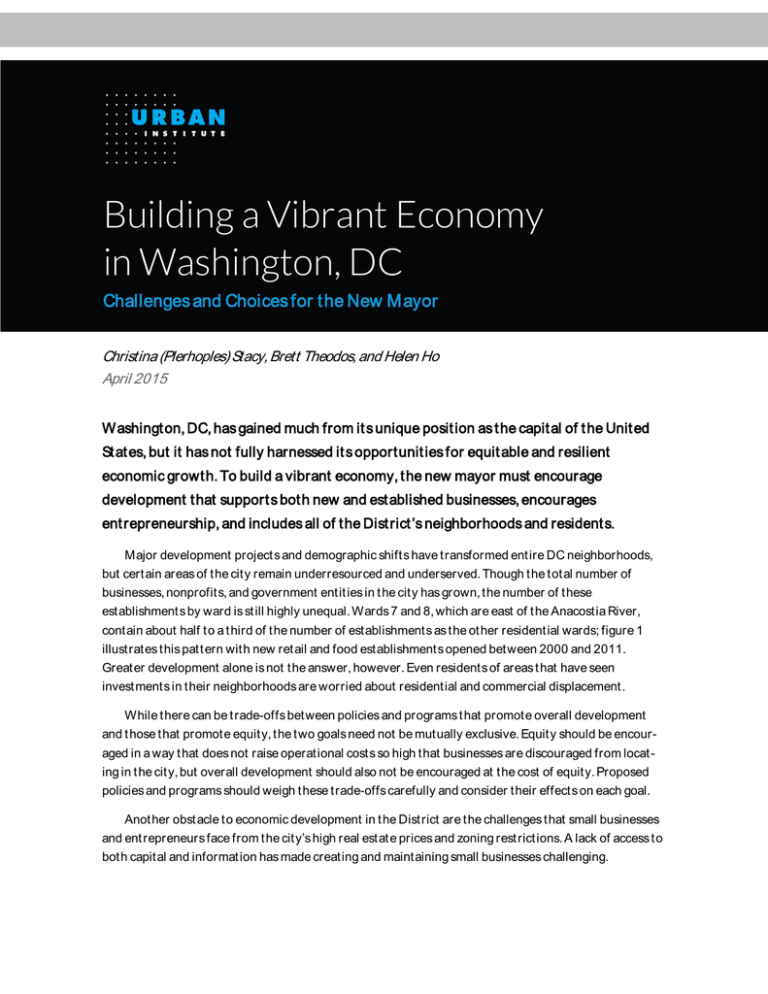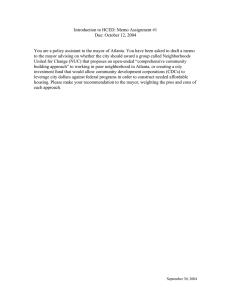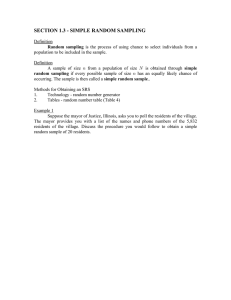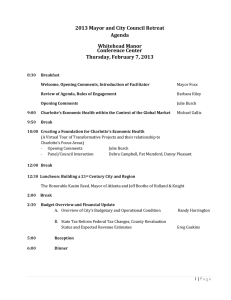Building a Vibrant Economy in Washington, DC
advertisement

Building a Vibrant Economy in Washington, DC Challenges and Choices for the New Mayor Christina (Plerhoples) Stacy, Brett Theodos, and Helen Ho April 2015 Washingt on, DC, has gained much from it s unique posit ion as t he capit al of t he Unit ed St at es, but it has not fully harnessed it s opportunit ies for equit able and resilient economic growth. To build a vibrant economy, the new mayor must encourage development t hat support s bot h new and est ablished businesses, encourages ent repreneurship, and includes all of t he Dist rict ’s neighborhoods and resident s. Major development project s and demographic shifts have transformed entire DC neighborhoods, but cert ain areas of the city remain underresourced and underserved. Though the total number of businesses, nonprofits, and government entit ies in t he city has grown, the number of these establishment s by ward is st ill highly unequal. Wards 7 and 8, which are east of t he Anacostia River, contain about half to a t hird of the number of establishments as the ot her residential wards; figure 1 illustrates this patt ern with new ret ail and food establishments opened between 2000 and 2011. Greater development alone is not the answer, however. Even residents of areas t hat have seen invest ments in their neighborhoods are worried about residential and commercial displacement. While there can be t rade-offs between policies and programs t hat promote overall development and t hose that promote equity, the two goals need not be mutually exclusive. Equity should be encouraged in a way t hat does not raise operational costs so high that businesses are discouraged from locating in t he city, but overall development should also not be encouraged at the cost of equity. Proposed policies and programs should weigh these trade-offs carefully and consider their effects on each goal. Anot her obst acle to economic development in t he Dist rict are the challenges that small businesses and ent repreneurs face from the city’s high real estat e prices and zoning rest rictions. A lack of access to both capital and informat ion has made creating and maintaining small businesses challenging. FIGURE 1 New Ret ail and Food Est ablishment s in W ashingt on, DC, bet ween 2000 and 2011 Source: National Establishment Time-Series database. Looking at the citywide economy, DC’s gross domest ic product (GDP) has grown significant ly, albeit with some stagnation in recent years (figure 2). Though it appears that much of this growth has occurred in private indust ry, a good portion of private GDP in DC is st ill government -led through contracting and grants. These contract s and grants have been fluctuating over t he past decade; t hey ran up aft er t he Great Recession because of stimulus funding and t hen declined t o pre-stimulus levels after those funds ran out. DC’s reliance on federal spending makes its economy part icularly vulnerable to federal spending fluctuations, which has led some to push for the diversification of indust ry and the strengthening of existing private industries. 2 B U I LD I N G A V I B RA N T ECO N O M Y I N W A SH I N GT O N , D C FIGURE 2 DC Gross Domest ic Product : Privat e Indust ry and Government Millions of 2009 dollars $120,000 All industries $100,000 $80,000 Private industry $60,000 $40,000 Government $20,000 $0 1997 1999 2001 2003 2005 2007 2009 2011 2013 Source: Bureau of Economic Analysis Regional Economic Information System. R ecommendations The mayor can take a number of steps to respond to these issues. R ecommendations in this memo are organized around three key challenges: Encouraging equitable economic development Fostering small business development and entrepreneurship Growing the citywide economy Encouraging Equit able Economic Development Though the District’s overall economy is fairly strong, equity both geographically and across socioeconomic groups remains a challenge. The mayor should take immediate steps to ensure that new development s serve equity goals and that all residents have equal access to exist ing opport unit ies. IMMEDIATE ACTION: Foster an inclusive development process through community engagement. M any long-time DC residents feel that recent economic developments have been implemented without their well-being in mind and that they do not have a voice in the process. T he DC government has hosted citywide and ward-specific summits to foster inclusion and generate recommendations, but community advocates feel that these recommendations have not been B U I LD I N G A V I B RA N T ECO N O M Y I N W A SH I N GT O N , D C 3 acted upon because of a lack of polit ical pressure. Mayor Bowser recently announced that she will be experimenting with OUR RFP, a new endeavor t o give the community the first opport unity t o shape development. Though conversat ions about equity have been held earlier in the development cycle on some ot her projects, as evidenced by the 11th St reet Bridge Park’s Equitable Development Task Force, t hese conversat ions need to t ranslat e into act ion on the part of the DC government. IMMEDIATE ACTION: Develop indicators of equitable growth and systematically track progress. It is fairly easy to track larger measures of economic growth, such as GDP and employment. B ut measuring progress toward equity, both geographically and between groups, is more difficult. The mayor should develop indicators to track equity over time and space and should maintain a public database of these measures. Use transit to create equal access to jobs and services. Jobs and services need not be equally distributed across the District, but access to them should be. The mayor should create this equal access by altering the regional transit infrastructure to promote commuting out of the city for work as well as commuting in. Though public transit can help people access jobs and amenities, introducing transit lines may have negative consequences, such as skyrocketing rents and the displacement of businesses and residents. Those potential consequences should be monitored and minimized. Require developers to ensure that existing residents gain from development deals. The city should take advantage of new development opportunities, such as St. Elizabeth’s and the FB I building, to create equitable development. R equirements such as community benefit agreements—which call for developers to provide specific amenities and/or mitigations to the local community or neighborhood—can help ensure that new developments support established residents and businesses. The trade-off between equity and overall development should be carefully weighed for each deal, so the requirements do not discourage businesses from locating in the District. Alter land use policies to bring in entry- and mid-level jobs with career pathways. Land use policy has kept out many employers that would create entry- and mid-level jobs matching the skills of much of DC ’s population. M any land parcels have been up-zoned for high-rise condominiums, while industrial and production-based businesses such as auto repair shops and plumbing supply warehouses have been zoned or priced out to surrounding suburbs. The first step in bringing these businesses and jobs to DC is to comprehensively study current and potential land uses in the city. M uch of the land that industrial businesses want to use is owned by the federal government or owned, managed, or in receivership by the city. The DC O ffice of Planning completed an industrial land transformation study for W ard 5 that can be a model for other wards. DC can also look to N orthern V irginia, which has maintained land for less high-end development. The mayor recently announced that the city will be supporting historic Anacostia by redeveloping a huge government-owned parcel there. O ther such redevelopments or sales should be undertaken as well. 4 B U I LD I N G A V I B RA N T ECO N O M Y I N W A SH I N GT O N , D C Encourage and retain new businesses that serve long-time residents through programs such as the Great Streets Initiative and training on the 504, SBA, and 7A loan programs. Despit e t he availability of support programs, not many businesses survived t he rapid development along the U St reet, 7th St reet, and 8th St reet corridors. As Anacostia redevelops, businesses that do not own t heir spaces may be displaced. The city should t rain businesses to effect ively use t he 504, SBA, and 7A loan programs, and it should improve and expand upon them. Systematically analyze the distributional effects of current policies. While considering new programs to creat e equity within the city, the DC government should analyze the effects of its current programs to ensure that they are not impeding equity goals. Take stock of DC’s ability to act as both a city and a state. As a state, DC has a larger portfolio of tools to use than other cities. For example, DC has jurisdiction over its welfare, criminal justice, and transportation policies and collects revenue from state and local taxes. DC has used some of its tools, such as the earned income tax credit, to redistribute funds. But other tools, such as Community Development Block Grants, could be used more strategically to promote equity. Promote connections between long-time and new residents through mixed-income development and spaces that encourage interaction. M ixed-income communities may still be segregated on a micro level, so the DC government should also promote development that brings people together across race and class, such as B usboys and Poets, B en’s C hili B owl, and public libraries. Track minority-owned businesses over time. R esearch has shown that minority-owned businesses 1 are more likely to hire minorities and can thus be used to promote racial equity. H owever, data are lacking about the number and types of minority-owned businesses in the District. The data that do exist are incomplete because businesses voluntarily report minority ownership and may not wish to disclose this information. T he mayor should work to remedy this data issue and maintain a database of minority-owned businesses throughout the District over time. Fost ering Small Business Development and Ent repreneurship Small businesses and entrepreneurs are important for many reasons, one of which is their role in stimulating innovation. M ayor B owser could build upon existing programs and initiatives to support small businesses and entrepreneurs and develop new ones. IMMEDIATE ACTION: Improve or streamline interactions between city government and businesses. Though the D epartment of C onsumer and R egulatory Affairs’ (DC R A’s) regulatory role is important to protect consumers and community members, its processes can impede the development of new and established small businesses. For example, entrepreneurs have to sift through over 160 licensing categories to find their own. And, some residents perceive that the permitting process is more about political connections and persistence than consumer protection. The mayor should take the following steps to improve this process: B U I LD I N G A V I B RA N T ECO N O M Y I N W A SH I N GT O N , D C 5 » Move more processes online. Businesses can benefit from DCRA’s guidance in navigat ing t he agency’s processes. In this spirit, t he depart ment is creating a business-facing online portal with all the required forms t o help ent repreneurs prepare for int eracting wit h the DC government. The portal can be improved by making in-person int eract ions with DCRA unnecessary unless a business application has a problem. For example, businesses should » be able t o check t he status of their applicat ions online. Create an ombudsperson position for small businesses. The department should have dedicated staff to answer questions from business owners and answer inquiries about the status of an application. A project manager in the deputy mayor’s office is already assigned to assist larger businesses; a similar role should be created in DCRA or the mayor’s office for small businesses. » Consolidate functions between agencies so entrepreneurs need interact with only one or two departments. C urrently, entrepreneurs need to interact with multiple agencies to establish their businesses, and the lack of communication among city agencies creates unnecessary hurdles. Functions should be consolidated between agencies, and information about business applications should be shared more easily between agencies. M emoranda of understanding and data-sharing systems would make the process more seamless. Improve technical assistance for businesses. » Build the technological capacity of small businesses. Small business owners need training in how to use technology to improve business performance. This ranges from using Excel for budgeting to using customer relationship management software and social media to increase sales. The city’s technical assistance should focus on helping entrepreneurs and small business owners build these skills. » Foster growth for existing small businesses. M any support systems are geared toward helping new companies start as opposed to helping established companies grow. Existing small businesses need guidance on how to get certified, how to incorporate, and how to receive special designations. T echnical assistance can also help businesses reposition and rebrand to adapt to lower federal funding. » Integrate DC’s technical assistance system. T he city’s support infrastructure for business technical assistance is highly disjointed and should be combined into one system. T he District can learn from the example of other cities—such as N ew York C ity—that have integrated their technical assistance systems. » Consider engaging universities in technical assistance. Universities in the area receive requests for assistance but do not have resources to support these efforts. M ayor B owser should explore ways to engage local universities in the technical assistance system. The mayor recently announced a new technology partnership with H oward University that will bolster efforts to support DC ’s growing technology and innovation sectors by addressing the needs of startups and entrepreneurs in the District. Similar partnerships should be made to address the needs of other types of startups and existing small businesses. 6 B U I LD I N G A V I B RA N T ECO N O M Y I N W A SH I N GT O N , D C Improve access to capital for small businesses. Many financial instit utions are reluctant to lend to small businesses because these loans are viewed as risky investments. Although DC has five Community Development Financial Inst itut ions, t hey operate at different t iers of financing, limiting the number of options available t o small businesses. These and other financial instit utions would be more willing t o lend if more risk sharing programs were available, such as the Department of Insurance, Securities, and Banking’s collat eral support program. The Great Streets initiat ive is a successful source of capital for small businesses in the Dist rict and has expanded t o 16 corridors, but it st ill has room for improvement and expansion. Better link small businesses with large businesses in the region through a value-chain approach. The value-chain approach, in which small businesses are connect ed t o larger businesses to link t he steps in their product’s lifeline, has been used successfully int ernationally. This approach should be explored in DC t o help integrat e small businesses and entrepreneurs int o increasingly compet itive value chains. The Hispanic Chamber of Commerce organizes matchmaking event s between small and large businesses to achieve this goal, and t he District should support and expand upon these efforts. Growing t he Cit ywide Economy Officials must often make t rade-offs between policies and programs that promote overall development and t hose that promote equity, since equity policies can raise t he cost of doing business. However, bot h objectives should be kept in mind, and the mayor should take st eps to strengthen t he overall economy without compromising equit y goals. IMMEDIATE ACTION: Support existing businesses. Most job growth comes from established businesses, not st art ups or relocated businesses. The fact that these employers are here and already operat ing means that DC is likely a promising place for them. The mayor should priorit ize support ing existing businesses. Identify sectors that are strong and those with growth potential, and focus on developing them. To understand how DC compares wit h the suburbs and ot her regions, t he mayor should analyze which sectors in the Dist rict are growing and which sect ors have t he potential to grow. Create and expand upon evidence-based policies. The mayor should implement and expand economic development policies and programs that have been proven effective t hrough evidence and data analyses. She should also commission analyses of programs that have not yet been proven successful. Grow DC’s export businesses through zoning and support. Businesses t hat export goods and services are likely to employ more people and improve t he balance of payment s for DC. In particular, the city’s comparative advant age lies in services. The mayor should speak with DC businesses that already export goods and services and t hose who would like to ent er the District in order to understand their barriers to growth and development. B U I LD I N G A V I B RA N T ECO N O M Y I N W A SH I N GT O N , D C 7 Tap into regional resources and strengthen regional coordination to build upon the region’s strengths. The mayor should take advantage of regional resources by collaborat ing with Virginia and Maryland at t he stat e and county levels. This strategy builds upon the region’s st rength, rather than at tempting to relocate new types of businesses to t he region. For example, the mayor should embark on t rade missions to market the region’s asset s and foster regional knowledge sharing by connecting the many federal labs. Focus on development east of the river. The mayor should explore the many opportunities for development and t ourism east of t he river, such as using vacant land for new businesses and services and preserving and promoting t he many historical sit es t o increase tourism. Lower the costs of doing business in DC. The Dist rict can examine its regulatory and tax sys-tems to find ways to make it easier to do business, such as reducing compliance costs. However, t he cost of doing business should be reduced without sacrificing equity in and among wards. Conclusion The District’s economy is still st rong, but the city must work quickly to ensure that new and existing developments are equitable, support small businesses, and grow the DC-wide economy. Although trade-offs oft en exist between t hese t hree goals, the mayor has many tools at her disposal t o make great strides in each of them. Note 1. “Whites Found Least Likely to Hire Minorities,” New York Times, September 20, 1987, http://www.nytimes.com/1987/09/20/us/whites-found-least-likely-to-hire-minorities.html. A BO UT TH E URBA N I N STI TUTE 2100 M Street NW Washington, DC 20037 www.urban.org The nonprofit Urban Institute is dedicated to elevating the debate on social and economic policy. For nearly five decades, Urban scholars have conducted research and offered evidence-based solutions that improve lives and st rengthen communities across a rapidly urbanizing world. Their object ive research helps expand opportunities for all, reduce hardship among the most vulnerable, and strengthen the effectiveness of the public sector. This brief was funded by the Open Society Foundations. We are grateful to our funders, who make it possible for Urban to advance its mission. It is important to note that funders do not determine our research findings or t he insights and recommendations of our experts. This memo is presented as part of Challenges and Choices for t he New Mayor, an initiative of the Urban Institute as part of Talking Transition DC. The views expressed are those of the authors and should not be attributed to Talking Transition DC or to the Urban Institute, its trustees, or its funders. Copyright © April 2015. Urban Institute. Permission is granted for reproduction of this file, with attribution to the Urban Institute. 8 B U I LD I N G A V I B RA N T ECO N O M Y I N W A SH I N GT O N , D C






